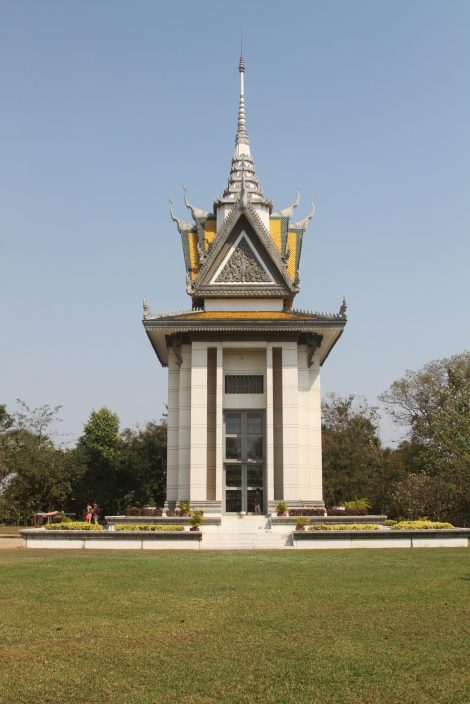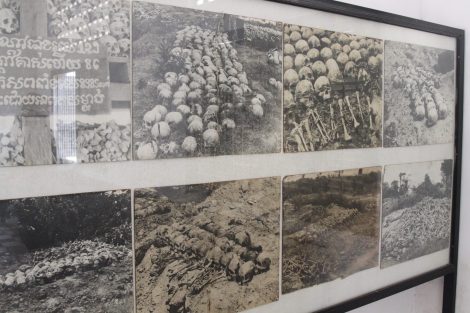Cambodia, home to over 14.8 million people, is best known for its famous ruins, Angkor Wat, but it is so much more than that. Starting in the early days when the Khmer Empire began in the 8th century, and lasted well into the 15th century as the powerhouse of South East Asia. The French had their hand in the mix after that, till the reign of the Khmer Rouge, and now, finally, it is back in the hands of Cambodians.
We rode out of Saigon on a very comfy bus, crossing over into Cambodia in six hours. The border crossing was modern, clean, and efficient. After a nice lunch at a roadside café, we arrived in Phnom Penh around 3 o’clock. Trying to get your bearings in the city is always chaos, with men hassling you for business, traffic a total nightmare, and everyone jostling your bags. We quickly negotiated with a tuk-tuk driver and tossed our bags in the back. Jeff chose a hotel that had a good reputation central to the palace and museum. It was booked of course, but we found one near by that was clean enough above a restaurant. Looking out of our windows you looked down at the Museum, which had the multilayered roofs with snakes staking out the corners. Being four o’clock we ran to the Royal Palace to see if we could get in the last tour, because we knew we had very limited time here. We were lucky to get there right before it closed, and hired a guide to walk us around.
The Royal Palace was really amazing, with series of buildings housing the royals, the throne room, and even elephant stands. The palace began construction in the 1860’s, and has been used up to the present by the royals, except during the Khmer Rouge period. Our guide was very good and told us all about the current King, Norodom Sihamoni, who had been a monk. He lived abroad most his life, in France and Czechoslovakia. We spent about an hour here, and really that was more than enough time to see all the buildings.
That night Yvonne and I made our first crucial mistake of the trip. We went to a touristy spot on the river, and ordered chicken and stir-fry noodles. Jeff got a chicken curry. Well, our dishes were slimy, with some nasty looking eggs worked into the noodles. I avoided the eggs, and ate only half before pushing the plate away in disgust. We left the restaurant and sat on the corner to have a beer. I had not even gotten my beer before my eyes bugged out and ran in search of the bathroom. It was draining to say the least. For the next five days it was going to be the same, with some horrible food poisoning.
On the corner there was a homeless mother with her daughter begging for money. The daughter was no older that two, and laid there completely lifeless. We had done a bit of reading on the bus, and learned that a lot of beggars actually rent children to use, and all the money goes to a pimp. They drug the kids, and there have even been times where the child actually dies, and they keep begging till they get relieved, then they get a different kid. It’s just horrible. It’s one of the main reasons I never give money to beggars anywhere. The kid here was alive, but really not in the greatest shape. Then they would have little girls coming up to you trying to sell postcards and other crap too you, in a very persistent manner. However, little if any of the money goes to the kids, more than not, it goes to the mafia in the area.
We had a full day planned, with a tuk-tuk tour planned and tickets in the afternoon to Siem Reap by bus. Imodium AD is my best friend on these trips, because the food poisoning was still wrecking me.
We took a tuk-tuk out of town for about a half hour to the Choeung Ek killing fields. During the 1970’s the US was doing illegal operations of bombing parts of Cambodia and Laos. The reasoning for this secret offensive was to kill Vietcong who were hiding in these areas. The Cambodian people were not having any of it, and because their King at the time was trying not to choose a side, it ended up making him seem incredibly weak. It also allowed a small gorilla group to gain power and pretty much march from the Mountains into the city and take control of the country. No one really knew much about them, but the people were happy for peace. This was the beginning of the darkest period of this countries history, and one of the worst genocides of its kind.
Pol Pot was the leader of this group, and he had some insane visions of a rural based agricultural society. He told all the people in the cities that the U.S. were planning on bombing them, and that they all had to march out of the city with only the shirts on their backs. He lied about all of that, and forced the people to march to camps where they were forced to work in the fields. Having glasses, speaking another language, any education above 6th grade meant was instant death sentences. It was clearly a homicidal maniac’s chance to wipe out over half of his own population.
It was one of these camps that we were visiting today. Though it does not look like anything more than a pleasant plot of land in the countryside, the Killing Fields hides the remains of thousands of people. In Choenung Ek there were 8,895 bodies found. In the center is a Stella that houses 5000 human skulls from people who were buried in mass graves around here. The Khmer Rouge would kill people using the spikes on Palm Oil trees, so not to waste bullets. The favorite saying of the the Khmer Rouge was “To keep you is no benefit. To destroy you is no loss.”1
They have a great walking/audio presentation here that you can use as you stop at different spots in the Killing fields explaining the atrocities that happened, and even audio from some of the actual survivors. When it rains here, more bones emerge all the time. We walked over areas carefully so not so disturb some of the bones we could actually see sticking out of the ground. The only experience comparable to this was Auschwitz, and this actually happened in my lifetime. There is a sense of peace here, with all the death that occurred, it seems like it has come to terms with the atrocities that had occurred here.
The next stop for us was the old high school where they tortured and killed political prisoners, or anyone really they felt like, named S-21 or Tuol Sleng. It’s a bleak and disturbing place, to think where thousands of children once went to be educated, was now being used as a torture and extermination center. Where once there were the sounds of laughter and bouncing balls, then there was just the moans and screams of the victims. It’s truly horrifying.
The school is two stories high, a U shaped building with a large courtyard on the inside. The prisoners were strapped spread eagle on old metal bed springs and tortured in more ways than anyone could think of. Our guide had lost numerous family members here, including his sister. He does the tours daily, yet you can see the pain in his eyes, recounting his history here. There are numerous paintings here from Vann Nath, one of the survivors, detailing in graphic detail everything. The images are so strong that I feel any words would do it injustice.
Near the exit, there are two tents with actual survivors from the school. Chum Mey was a mechanic who was in the school for two years. Another survivor was there also, who painted a lot of the paintings from his experiences in S-21. I am amazed that he has the strength to show up to this place that was so horrible to him, feet from where he was held. It’s heart breaking but also really inspirational that he wants to tell his tale, in the hopes that this will not happen again.
For more information I highly recommend renting the movie The Killing Fields, or buying the book. Its about Dith Pran, a Cambodian journalist who escaped the killing fields and told the world about it.
No visit to Cambodia should be without a stop at these places. I feel it is important for people to understand how quickly society can break down, and the horrible things that happen when it does.
1^ Crochet, Soizick (1997). Le Cambodge. Paris: Karthala. ISBN 2-86537-722-9. Retrieved December 20, 2011.

































Cambodian, Thai, Burmese, Laotian until Malaysia share many similarities with us, Indonesians..particularly in cultural influences. When I watched Thai or Cambodian classical dances I feel like watching my Indonesian ones in front of….as if seeing ourselves in the mirror.
Fascinating juxtaposition of horror and beauty.
Thanks you. It was a tough subject to write about, but I feel like there is a lot of healing still going on.
I can’t possibly say I ‘like’ this. The images are too painful – and it looks like there is still a lot suffering there…
Yeah, I was torn about this blog. Possibly I should have focused on one or the other. But at the same time healing is going on, hopefully, sites like this will educate so no things wont happen like this again.
Yeah – and I guess we can’t bury our heads in the sand and forget…